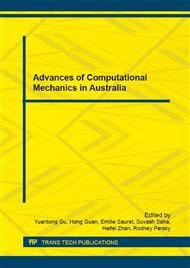[1]
H. Kolsky, Stress waves in solids, J. Sound. Vib. 1 (1964) 88-110.
Google Scholar
[2]
R.Y.S. Pak, B.B. Guzina, Three-dimensional wave propagation analysis of a smoothly heterogeneous solid, J. Mech. Phys. Solids. 43 (1995) 533-551.
DOI: 10.1016/0022-5096(94)00080-o
Google Scholar
[3]
J.C. Santamarina, A. Klein, M.A. Fam, Soils and waves: Particulate materials behavior, characterization and process monitoring, J. Soils. Sediments. 1 (2001) 130-130.
DOI: 10.1007/bf02987719
Google Scholar
[4]
E.N. Hiestand, Mechanical properties of compacts and particles that control tableting success, J. Pharm. Sci. 86 (1997) 985-990.
DOI: 10.1021/js9701061
Google Scholar
[5]
E.T. Brown, Block Caving Geomechanics: International Caving Study 1997-2004, Julius Kruttschnitt Mineral Research Centre, The University of Queensland, (2007).
Google Scholar
[6]
B.A. Wills, Wills' mineral processing technology: an introduction to the practical aspects of ore treatment and mineral recovery, Butterworth-Heinemann, (2011).
DOI: 10.2138/am.2008.502
Google Scholar
[7]
A.M. Rajendran, W.M. Ashmawi, M.A. Zikry, The modeling of the shock response of powdered ceramic materials, Computation. Mech. 38 (2006) 1-13.
DOI: 10.1007/s00466-005-0712-3
Google Scholar
[8]
L. Shen, Molecular dynamics study of dynamic responses of glassy silica under shock impact, CMC-Comput. Mater. Contin. 15 (2010) 241-260.
Google Scholar
[9]
L. Shen, A rate-dependent damage/decohesion model for simulating glass fragmentation under impact using the material point method, CMES-Comput. Model. Eng. Sci. 14 (2009) 23-46.
Google Scholar
[10]
Z. Xu, H. Hao, H.N. Li, Experimental study of dynamic compressive properties of fibre reinforced concrete material with different fibres, Mater. Design. 33 (2012) 42-55.
DOI: 10.1016/j.matdes.2011.07.004
Google Scholar
[11]
K. Kendall, Agglomerate strength, Powder. Met. 31 (1988) 28-31.
Google Scholar
[12]
J. Subero, M. Ghadiri, Breakage patterns of agglomerates, Powder. Technol. 120 (2001) 232-243.
DOI: 10.1016/s0032-5910(01)00276-5
Google Scholar
[13]
S. Antonyuk, M. Khanal, J. Tomas, S. Heinrich, L. Mörl, Impact breakage of spherical granules: experimental study and DEM simulation, Chem. Eng. Process. 45 (2006) 838-856.
DOI: 10.1016/j.cep.2005.12.005
Google Scholar
[14]
Z. Chen, R. Feng, X. Xin, L. Shen, A computational model for impact failure with shear‐induced dilatancy, Int. J. Numer. Method. Eng. 56 (2003) 1979-(1997).
DOI: 10.1002/nme.651
Google Scholar
[15]
J.R. Valdes, F.L. Fernandes, I. Einav, Periodic propagation of localized compaction in a brittle granular material, Granul. Matter. 14 (2012) 71-76.
DOI: 10.1007/s10035-011-0302-3
Google Scholar
[16]
F. Guillard, P. Golshan, L. Shen, J.R. Valdes, I. Einav, Dynamic patterns of compaction in brittle porous media, Nat. Physics. (2015).
DOI: 10.1038/nphys3424
Google Scholar
[17]
S.G. Bardenhagen, J.U. Brackbill, D. Sulsky, The material-point method for granular materials, Comput. Method. Appl. Mech. Eng. 187 (2000) 529-541.
DOI: 10.1016/s0045-7825(99)00338-2
Google Scholar
[18]
S.G. Bardenhagen, J.E. Guilkey, K.M. Roessig, J.U. Brackbill, W.M. Witzel, J.C. Foster, An improved contact algorithm for the material point method and application to stress propagation in granular material, CMES-Comput. Model. Eng. Sci. 2 (2001).
Google Scholar
[19]
I. Alduán, M.A. Otaduy, SPH granular flow with friction and cohesion, Proceedings of the 2011 ACM SIGGRAPH/Eurographics symposium on computer animation, (2011) 25-32.
DOI: 10.1145/2019406.2019410
Google Scholar
[20]
Z. Chen, W. Hu, L. Shen, X. Xin, R. Brannon, An evaluation of the MPM for simulating dynamic failure with damage diffusion, Eng. Fracture. Mech. 69 (2002) 1873-1890.
DOI: 10.1016/s0013-7944(02)00066-8
Google Scholar
[21]
D. Sulsky, A Numerical Study of Compaction of Dry Granular Material, MRS Proceedings, 759 (2002) MM3-1.
DOI: 10.1557/proc-759-mm3.1
Google Scholar
[22]
Z. Więckowski, The material point method in large strain engineering problems, Comput. Method. Appl. Mech. Eng. 193 (2004) 4417-4438.
DOI: 10.1016/j.cma.2004.01.035
Google Scholar
[23]
Y.D. Murray, Users manual for LS-DYNA concrete material model 159, No. FHWA-HRT-05-062, (2007).
Google Scholar
[24]
Y.D. Murray, A.Y. Abu-Odeh, R.P. Bligh, Evaluation of LS-DYNA concrete material model 159, No. FHWA-HRT-05-063, (2007).
Google Scholar
[25]
K.R. Linger, D.G. Holloway, The fracture energy of glass, Phil. Mag. 18 (1968) 1269-1280.
Google Scholar


